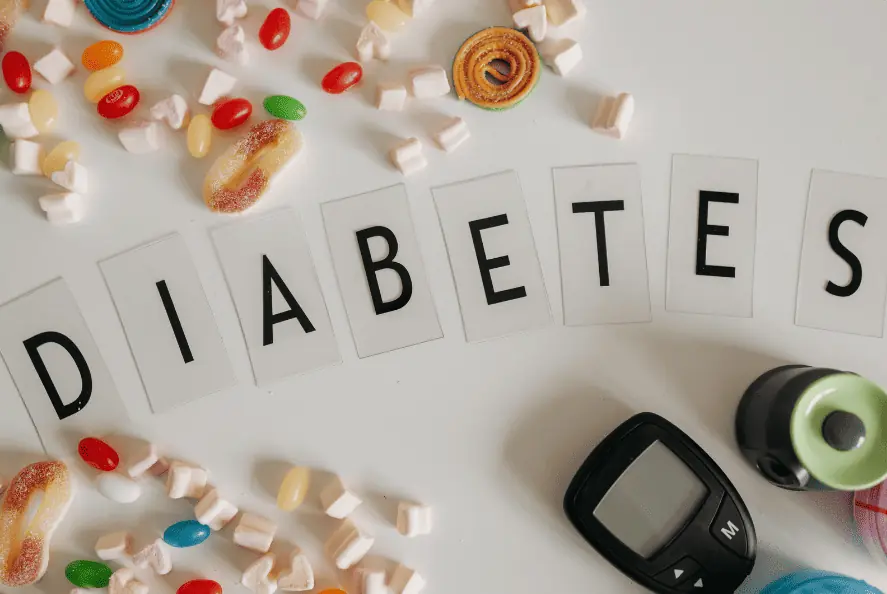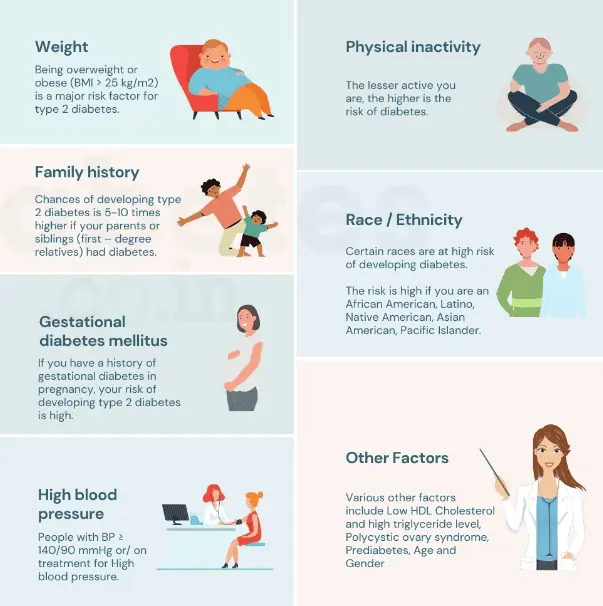Introduction
Welcome to a comprehensive exploration of Diabetes Mellitus Type 2 and prediabetes. These metabolic disorders affect millions of people worldwide. Our healthcare professionals serving Victorville, CA, Hesperia, CA and Apple Valley, CA, provide a clear understanding of these conditions in friendly language.
Understanding Diabetes Mellitus Type 2 and Prediabetes
Overview
Diabetes Mellitus Type 2 and prediabetes are conditions where the body struggles to manage blood sugar due to insulin resistance. Insulin is a hormone that helps our cells absorb sugar from the blood to use for energy. When the body becomes resistant to insulin, blood sugar levels rise, leading to these conditions. Prediabetes is an early warning sign where blood sugar is higher than normal but not high enough to be classified as diabetes. CDC
Causes and Risk Factors
These conditions can be caused by several factors, including genetic predisposition, lifestyle factors, and obesity, having a family history of type 2 diabetes, lack of regular exercise, had gestational diabetes when you were pregnant, have polycystic ovarian syndrome, have high blood pressure, have high cholesterol and if you are older than 45. In particular, carrying excess weight around the abdomen increases the risk as it makes the body more resistant to insulin. CDC
Symptoms and Early Signs
The early signs of Diabetes Mellitus Type 2 and prediabetes can be subtle and easily overlooked. These signs include increased thirst, frequent urination, unexplained weight loss, constant fatigue, blurred vision, frequent infections, slow-healing sores, and areas of darkened skin. If you notice any of these symptoms, it’s important to seek medical advice promptly. Early detection and treatment can prevent these conditions from progressing and causing further health complications. Mayo Clinic
Diagnosis
Diagnosis of these conditions is based on blood tests that measure your blood sugar levels. For Diabetes Mellitus Type 2, a fasting blood sugar level of 126 mg/dL or higher on two separate tests indicates diabetes. For prediabetes, a fasting blood sugar level from 100 to 125 mg/dL is considered prediabetes. Another test used for diagnosis is the Hemoglobin A1C test. An A1C level of 6.5 percent or higher on two separate tests indicates diabetes, while an A1C level between 5.7 and 6.4 percent is considered prediabetes. Mayo Clinic
Schedule your Diabetes Screening with Dr. Moqattash at Modele Primary Care. Early detection can prevent progression and complications. Take control of your health, call us now!
What is Blood Glucose (Sugar)?
Blood glucose, also known as blood sugar, is the main sugar found in your blood. It comes from the food you eat, and is your body’s main source of energy. Glucose is carried to the cells through the bloodstream. The hormone insulin helps the cells absorb glucose and use it for energy.
How is A1C Calculated?
A1C is a blood test that provides information about a person’s average levels of blood glucose over the past 3 months. The A1C test measures the percentage of hemoglobin cells in the blood that have glucose attached to them. The higher the glucose level in the blood, the higher the A1C level will be.
Causes of Falsely Low A1C Results
Certain conditions can result in falsely low A1C results. These include any condition that leads to a shorter than normal lifespan of red blood cells, such as hemolytic anemia or certain blood disorders. Pregnancy can also lower A1C levels. In addition, some genetic disorders affecting hemoglobin, like hemoglobinopathy, can skew A1C test results.
Causes of Falsely High A1C Results
On the other hand, conditions that increase the lifespan of red blood cells can lead to falsely high A1C results. This includes some types of anemia and kidney disease. High levels of triglycerides in the blood can also increase A1C levels.
Management and Treatment Approaches
Lifestyle Modifications
Lifestyle changes are crucial for managing Diabetes Mellitus Type 2 and prediabetes. A balanced diet and regular physical activity can help control blood sugar levels. Dietary changes can include reducing intake of processed foods, sugary drinks, and high-fat foods. Instead, focus on eating more fruits, vegetables, whole grains, lean proteins, and healthy fats. Regular physical activity, such as walking, swimming, cycling, or even gardening, can also help control blood sugar levels. Mayo Clinic For diabetic-friendly recipes, visit Diabetes Food Hub.
Medication and Therapeutic Options
There are several medications available to manage blood sugar levels. Some help the body produce more insulin, others improve insulin effectiveness, and some slow down the digestion of carbohydrates. The latest guidelines recommend metformin as the first-line treatment, with other drug classes such as SGLT-2 inhibitors and GLP-1 receptor agonists also being used based on individual patient factors.
Innovations in Diabetes Care
Innovations in diabetes care include continuous glucose monitoring systems and new medications that lower blood sugar and help with weight loss and heart health. Continuous glucose monitoring systems can track blood sugar levels in real-time, providing valuable insights for better management. Newer medications not only lower blood sugar but also have heart-protective properties and can aid weight loss, which is beneficial for many patients with type 2 diabetes.
Complications of Uncontrolled Diabetes
Uncontrolled diabetes can lead to both short-term and long-term complications. Short-term complications include hypoglycemia (low blood sugar) and hyperglycemia (high blood sugar), which can both have dangerous consequences if not treated promptly. Long-term complications can affect almost every organ in the body. They include heart disease, stroke, kidney disease, eye problems, dental disease, nerve damage, and foot problems.
Recommended Routine Screenings for Patients with Diabetes
Regular screenings are essential for early detection and management of diabetes complications. They include foot exams to check for sores, cuts, or ulcers that may not be healing properly; eye exams to check for retinal damage; kidney function tests; and regular blood pressure checks. Regular A1C testing is also crucial to monitor blood sugar control over time. CDC
Expert Insights
Managing Diabetes Mellitus Type 2 and prediabetes is a team effort. It involves healthcare providers, patients, and their families working together.
Conclusion
We hope this comprehensive guide on Diabetes Mellitus Type 2 and prediabetes empowers you with knowledge. By understanding these conditions and taking proactive steps, you can effectively manage your health and lead a fulfilling life.
Frequently Asked Questions (FAQs)
Can Diabetes Mellitus Type 2 and Prediabetes be Prevented?
Yes, lifestyle modifications can significantly lower the risk of developing these conditions.
What Dietary Choices are Recommended for Individuals with Diabetes Mellitus Type 2 and Prediabetes?
A diet rich in whole grains, fruits, vegetables, and lean proteins, low in saturated fats and sugars is recommended.
How Does Physical Activity Impact Diabetes Management?
Physical activity helps the body use insulin more effectively, lowers blood sugar levels, and helps maintain a healthy weight
Are There Any Natural Remedies for Managing Diabetes Mellitus Type 2 and Prediabetes?
While there’s no substitute for a healthy lifestyle and prescribed medication, some natural remedies may provide additional benefits.
How Often Should Individuals with Diabetes Mellitus Type 2 and Prediabetes Monitor Their Blood Sugar Levels?
Regular monitoring is crucial. The American Diabetes Association recommends that most individuals with diabetes aim to keep their A1C levels below 7%.
What is the role of the A1C test in diabetes management?
The A1C test measures your average blood sugar level over the past 2 to 3 months.
Can I still eat sweets if I have diabetes?
Yes, but in moderation and as part of a balanced diet.
What are the common complications of uncontrolled diabetes?
Complications can include heart disease, stroke, kidney disease, eye problems, dental disease, nerve damage, and foot problems.
How often should I get my eyes checked if I have diabetes?
People with diabetes should have an eye exam at least once a year.
Can type 2 diabetes turn into type 1 diabetes?
No, these are two different types of diabetes and one cannot turn into the other.
Can stress affect my blood sugar levels?
Yes, stress can increase your blood sugar levels.
Can I drink alcohol if I have diabetes?
Yes, but in moderation and with a meal to prevent low blood sugar.
Contact Dr. Moqattash at Modele Primary Care for Diabetes screening or management. We’re here to support you in your health journey. Don’t delay, call us today!




When someone writes an paragraph he/she retains the thought of a user in his/her mind that how a user can understand
it. Thus that’swhy thios piece of writing is outstdanding.
Thanks!
Feel free to surf to my page: https://Www.waste-ndc.pro/community/profile/tressa79906983/
I think this is among the most vital info for me.
And i am glad reading your article. But wanna remark on some general
things, The web site style is ideal, the articles is really nice :
D. Good job, cheers
I’m grateful for the peace of mind this product provides. It tracks my glucose levels and helps me stay in control of my diabetes.
Good day! This is my 1st comment here so I just
wanted to give a quick shout out and say I really enjoy reading your articles.
Can you recommend any other blogs/websites/forums that go
over the same subjects? Thank you!
It’s very trouble-free to find out any matter on web as compared to books,
as I found this piece of writing at this site.